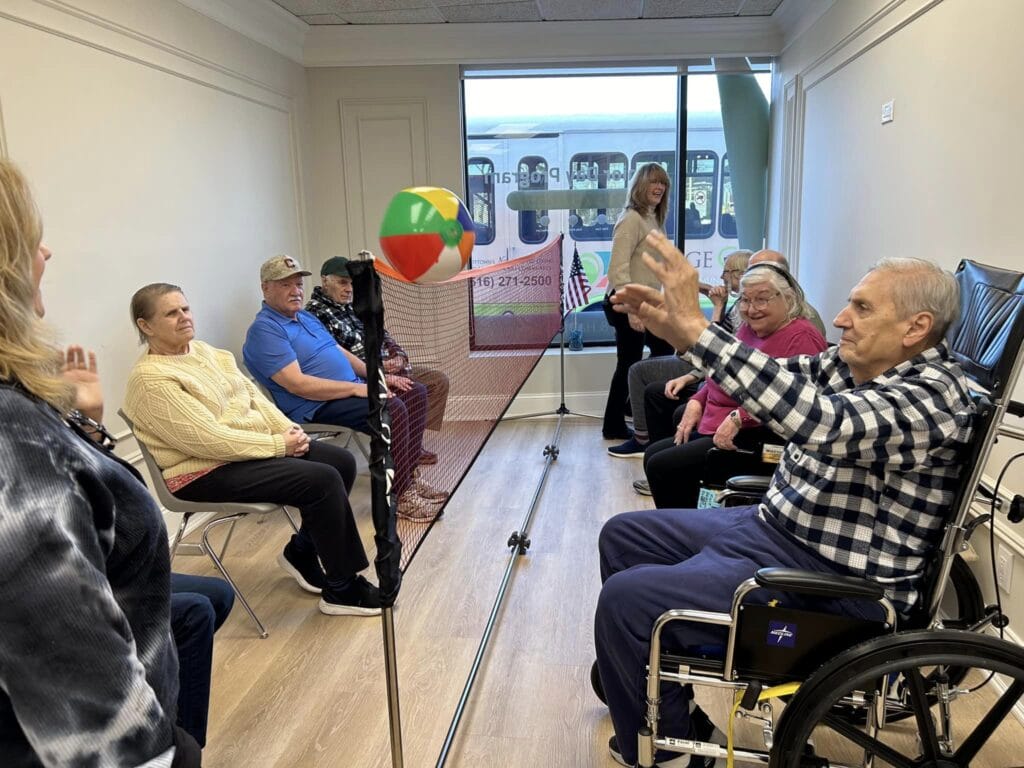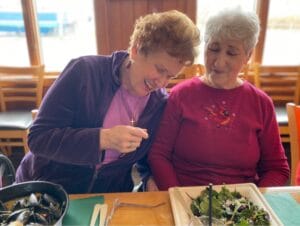Seniors and families of seniors: we’d love your input on a few questions. Have you noticed that performing activities of daily living becomes more challenging with age? Have you tried different strategies to cope, but aren’t finding the success you’d like? Occupational therapy can help.
One of the most challenging parts of aging is learning to accept that our bodies and minds aren’t able to do what they used to in early age. As such, navigating the changes in our bodies can be confusing, frustrating, and sometimes embarrassing.
If you’re experiencing challenges adapting to the aging process, know that there’s hope. Because with occupational therapy, you and/or your loved one can take control of your life — and we’ll explain how.
Village Green here: we’re Levittown, NY’s assisted living and memory care community of choice. Located in the heart of Nassau County, New York, our expert occupational therapists have decades of experience helping seniors and their families cope with aging.
If you’re wondering how occupational therapy can help you or a senior you love, this quick article can help.
Follow along as we explore what occupational therapy for seniors is, its benefits, activities it supports, and much more.
Occupational therapy for seniors explained
You may have heard of physical therapy for seniors before, but occupational therapy? Occupational therapy is completely different from physical therapy.
Occupational therapy helps people build, maintain, and resume skills associated with activities of daily life. Note: activities of daily life are often termed “occupations”.
The type of occupational therapy that a person receives differs depending on each patient’s needs. In general, occupational therapists help educate a patient, their caregiver, and their support team to help navigate the occupations and activities of a senior’s life.
Speaking of occupations and activities, let’s take a look at activities occupational therapists support.
Occupational therapy activities for seniors
Occupational therapy for seniors is all about helping seniors with daily self-care tasks and activities of daily living (ADLs). Some of the most common ADLs include:
- Eating
- Bathing
- Dressing
- Taking medication
- Using the restroom
- Transferring from one place to another (such as a bed to a chair, or a chair to a shower, or the toilet to another room)
Also, occupational therapists help with instrumental activities of daily living (IADLs). IADLs use cognition, thinking, and social skills.
Some of the most common IADLs occupational therapists support a senior with include:
- Managing medication regimes
- Managing money
- Driving
- Preparing meals
- Shopping
- Using mobile devices, such as computers or cell phones
Because every senior is different, an occupational therapist will prepare occupational therapy sessions in different ways. As a whole, though, the format of each occupational therapy session remains the same.
Let’s take a look at the anatomy of a typical occupational therapy session.
Anatomy of an occupational therapy session
A well-organized occupational therapy session can help seniors manage their conditions. The flow of each occupational therapy session looks something like the following:
- Assessment: First, an occupational therapist (OT) assesses a patient’s current level of functioning. The OT will review your health history, observe you doing certain tasks, and discuss what life activities present challenges for you, your caregiver, and others involved in your care team.
- Treatment plan: Next, the OT will create a treatment plan with short and long-term goals.
- Activities: Then, you’ll engage in a few helpful activities for the mind and body. An OT will help you work with assistive devices so you can function with greater freedom and ease.
- Lifestyle adaptations: Finally, the OT will show you ways to do tasks, such as getting dressed, getting in and out of the shower, exercises to improve and strengthen the body, ways to prevent falls, and how to use health tools and fitness devices to live a happier, healthier, and more functional life.
Depending on a person’s needs, an occupational therapist might meet with a patient once a week or more. After the session is complete, they’ll write up a detailed report.
The OT will also write action items for the patient and the OT to complete for the next session.
Benefits of occupational therapy for seniors
Occupational therapy for seniors can help elderly people with activities of daily living.But did you know that occupational therapists can help older elderly patients regain memory skills?
Some of the many benefits of occupational therapy for seniors include:
- Helping seniors overcome everyday life struggles
- Having confidence, determination, and a better outlook on the aging process
- Creating home modifications to help seniors complete everyday tasks with greater success
- Helping those who suffer from vision loss or eye diseases to have a better quality of life
- Support with creating healthy lifestyle habits and managing life transitions
- Helping patients with dementia regain memory skills, restructure life, and build new habits
- Offering help to caregivers with everyday activities takes the pressure off a caregiver. OT support ensures caregivers maintain a quality of life.
Health conditions served with occupational therapy for seniors
Occupational therapists help older adults improve physical abilities, motor skills, cognitive skills, and rehabilitation.
Some of the most common health conditions an occupational therapist helps with include:
- Stroke
- Support through the seven stages of dementia
- Traumatic brain injuries
- Arthritis
- Cancer
- Depression
- Diabetes
- Chronic pain
- Vision problems
- Joint replacements
- And more
An occupational therapist assigns seniors an exercise care plan full of activities to help improve daily life. OTs help seniors assess home environments to maximize the quality of life for both seniors and their loved ones.
Did you know?
At our assisted living facility, we aim to ensure our residents have an environment that will give them the autonomy, functionality, and independence they deserve. We’re thrilled to announce our new partnership with Dr. Amir Amrami PT, DPT, Owner and CEO of Achieve at Home Physical and Occupational Therapy!
Located on the third floor of our community, our newly renovated physical and occupational therapy studio invites residents to put their health and safety first while continuing to build strength and mobility. Whether needing help with range of motion, or performing everyday activities, our therapists can teach seniors how to live a quality life with quality, science-backed therapeutic interventions.
To learn more, explore our health and wellness offerings!
Village Green’s assisted living offers occupational therapy for seniors
Occupational therapy (OT) for seniors helps with a myriad of lifestyle, cognitive, social, physical, and motor-related conditions. With more than 18,000 unintentional fatal injuries occurring nationwide each year (CDC, 2023), occupational therapists can help seniors live safer and healthier lives.
Whether aging in place or at a senior care community, we want you to know that you can always reach out to our knowledgeable and friendly occupational therapists for any questions you may have about senior occupational therapy. Our senior care team would be more than happy to help.
To reach one of our OTs or senior advisors, contact us today.
Frequently asked questions about occupational therapy for seniors
Where do occupational therapy sessions take place?
Occupational therapists (OTs) and occupational therapist aides (OTAs) work in different settings including:
- Assisted living centers
- Nursing homes
- Hospitals
- In- and outpatient clinics
- Rehabilitation centers
- In a patient’s home
Which factors affect the cost of occupational therapy?
The cost of occupational therapy depends on a few factors including:
- The session length
- Whether the therapy takes place in a care facility or a patient’s home
- The therapeutic interventions provided during therapy
Every occupational therapy clinic, therapist, and service provider is different. So, you’ll want to check with your healthcare provider to determine the cost of an occupational therapy session.
Do all senior care communities offer occupational therapy?
Not all senior care communities offer occupational therapy. Many assisted living facilities, memory care neighborhoods, and skilled nursing homes provide occupational therapy.
Also, some adult daycare service centers provide occupational therapy services.




